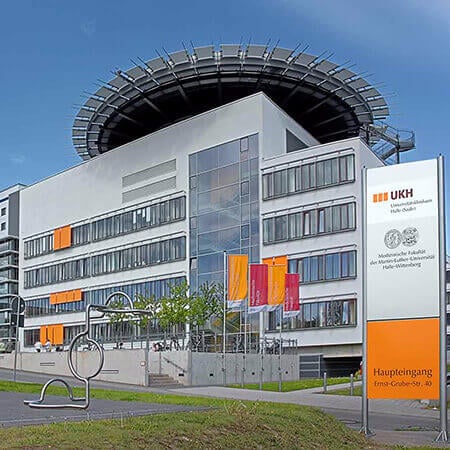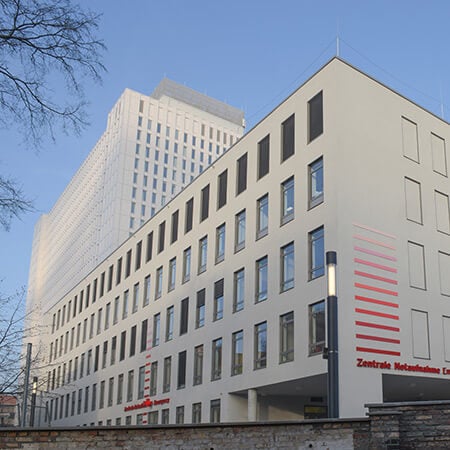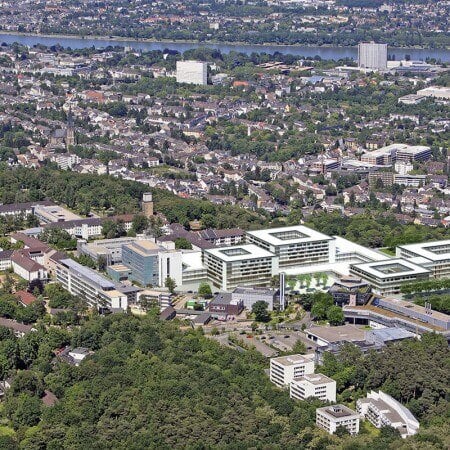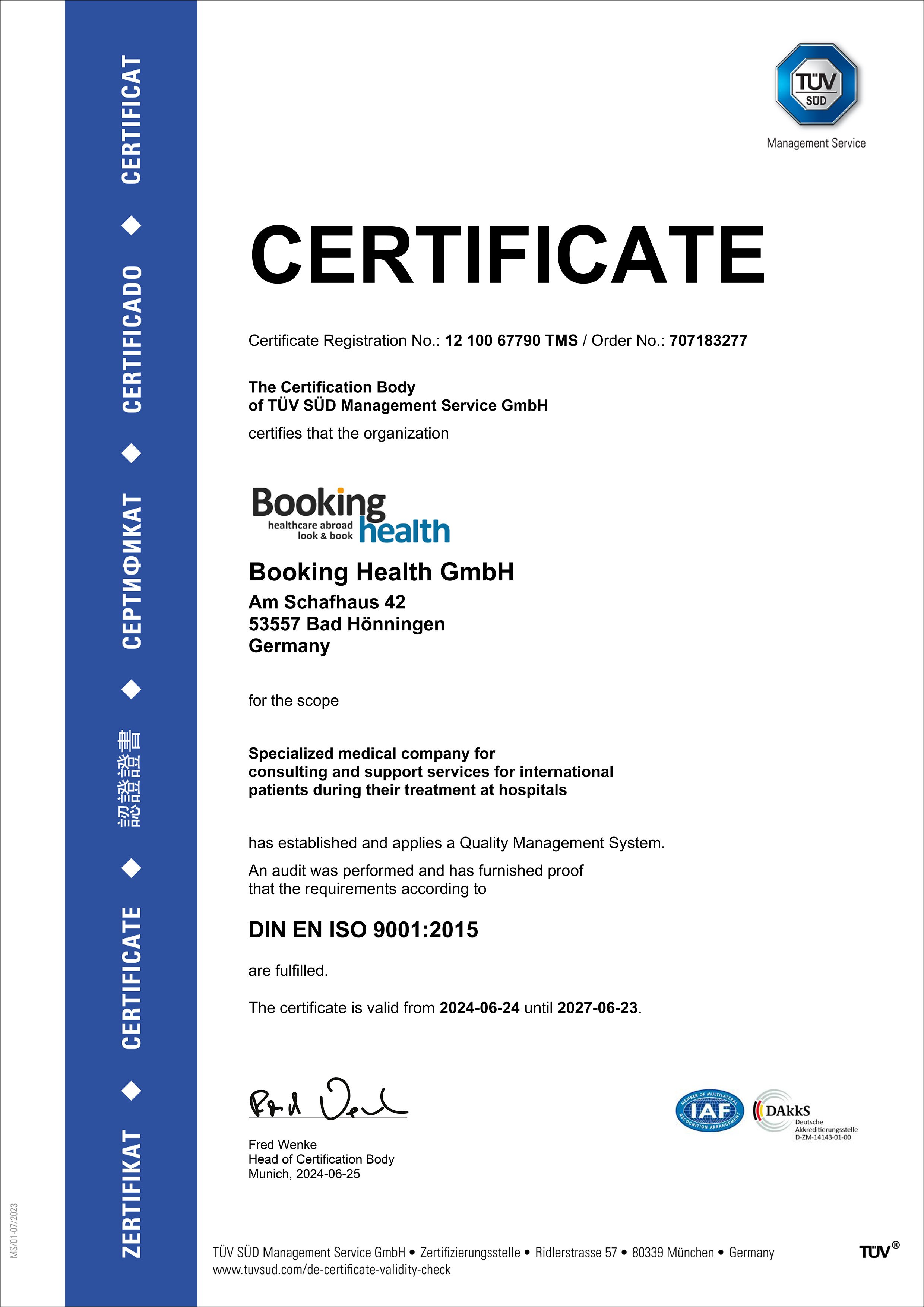Hodgkin lymphoma (lymphogranulomatosis) is cancer that affects and destroys the human lymphatic system. With timely and competent treatment, up to 90% of patients recover. Systemic chemotherapy and radiation therapy are mostly used for Hodgkin lymphoma treatment.
Content
- Clinical manifestations
- Risk factors
- Diagnostics
- Treatment options
- Chemotherapy
- Radiation therapy
- Prognosis
- Hospitals for treatment abroad
- Price range
- Undergoing treatment abroad with Booking Health
Clinical manifestations
At the early stages of Hodgkin lymphoma, there are no specific cancer signs, and its first manifestation is usually an increase of lymph nodes in various body regions. In 60-75% of cases, the cancer process starts in the cervical and supraclavicular lymph nodes. In 15-20% of cancer patients, Hodgkin lymphoma begins with an increase in the lymph nodes of the mediastinum.
Starting in the lymph nodes, the cancer process can spread to almost all organs and tissue types. It is accompanied by intoxication that may be either mild or rather severe.
Hodgkin lymphoma most commonly affects the lung and bone tissue. Lung lesions may not be accompanied by severe cancer symptoms, and the involvement of bones in the process is manifested by pain. The cancer impact on the liver is detected late due to the large compensatory capabilities of this organ. The liver usually enlarges, the activity of alkaline phosphatase increases, and serum albumin level decreases.
During the period of extensive manifestations of Hodgkin lymphoma, damage to all lymphoid organs and systems of the body is possible.
Frequent symptoms of this type of cancer include fever, increased sweating, skin itching, and weight loss. Itching of the skin occurs in about 25-35% of people with Hodgkin lymphoma. It has different options of manifestation: from mild itching in a small area to generalized dermatitis with itching all over the body. Such itching is very painful for a patient with Hodgkin lymphoma; it deprives him of sleep and even leads to mental disorders.
Risk factors
Factors provoking Hodgkin lymphoma include:
- Epstein-Barr virus. People with this health condition have a risk of lymphatic system cancer.
- Age. Although Hodgkin lymphoma is observed at any age, cancer is most often detected in adolescents and the elderly people.
- Heredity. Siblings of people with lymphatic system disorders have an increased risk of cancer occurrence.
- Dysfunction of immunity. If the immunity is weakened then the risk of Hodgkin lymphoma development is higher.
Diagnostics
Doctors from oncology hospitals refer patients to several laboratory and instrumental examinations:
- Thorough medical examination, which assesses the severity of cancer of the lymphatic system
- Laboratory blood tests, including a complete blood count and biochemical blood tests, immunoglobulin levels, etc.
- X-ray examination of the thoracic and abdominal cavities organs
- Biopsy and morphological examination of the harvested material using immunohistochemical methods
Additional examination methods that can be recommended to the patient include MRI, endoscopic examination, and bone scintigraphy.
Treatment options
Before the 60s, clinicians didn’t know how to treat Hodgkin lymphoma; radiation therapy was simply prescribed. After that they began to apply medications, and original comprehensive treatments were elaborated. Then they began to combine chemotherapy with radiation therapy. Finally, new imaging methods (CT and MRI scan) led to a breakthrough. Specialists singled out cancer patients with favorable prognosis already at the diagnostic stage: these patients weren’t treated aggressively.
Now, Hodgkin lymphoma treatment usually involves the combined use of particular methods of cancer care that include chemotherapy and radiation therapy.
A tumor doesn’t develop rapidly, which makes it possible to use conservative treatment options. Nevertheless, in some cases, doctors at oncology hospitals raise the question about the necessity of autologous hematopoietic stem cell transplants. Such transplant is indicated for patients with cancer progression or relapse, if radiation therapy haven’t been performed during the previous Hodgkin lymphoma treatment.
Chemotherapy
If information concerning the initial lesion’s volume is available, it’s recommended to have a consultation with hematologists-oncologists before starting chemotherapy. Doubtful or probable lesion areas should be especially highlighted.
Chemotherapy is one of cancer treatments that uses medication to suppress the cancer cells division by preventing their growth and/or cause their death.
Systemic and regional chemotherapy are applied for Hodgkin lymphoma treatment. The difference is that in systemic therapy with parenteral and oral administration drug solutions immediately get into systemic blood flow and can affect cancer cells of different localization. In regional therapy, they affect cancer cells in a chosen organ or a separate body cavity.
Chemotherapy can be combined with targeted treatments.
Targeted therapy includes treatments of cancer with special antibodies manufactured in a laboratory. Such substances can identify certain proteins (receptors) of cancer cells and normal cells. When targeted drugs recognize specific receptors, they attach to them, destroy cancer cells, and suppress their growth factor.
Radiation therapy
As for the radiation therapy for Hodgkin lymphoma treatment, there were also breakthroughs. Earlier, the dose of radiation therapy was higher, and the whole body was irradiated. The better the primary diagnostics developed, the better doctors at oncology hospitals saw the affected area, and the more subtle the methods of radiation therapy became. Radiation therapy now hits exactly the target. When prescribing Hodgkin lymphoma treatments, radiation therapy specialists calculate the dose that is given to the tumor itself and the dose that is given to nearby tissues, prioritizing minimal damage to them.
At the same time, modern Hodgkin lymphoma treatments imply maximum efficiency at any stage. If after two courses of chemotherapy cancer doesn’t change the rate of progression, radiation therapy is started. If cancer slows down, it may not be treated with radiation therapy.
The precision of the stage of cancer identification before chemotherapy is very important in planning radiation therapy. Description of lesions according to information from clinical examinations, CT scan and MRI should include their anatomical localization and maximum dimensions in centimeters.
The main feature of radiation therapy as a component of multimodal Hodgkin lymphoma treatment is adjustment of dosages. Radiation therapy is performed before the chemotherapy program starts. An optimal interval between chemotherapy and radiation therapy is 2-4 weeks (but not more than 6 weeks).
The adjuvant radiation therapy is very important in predominant Hodgkin lymphoma treatment. Here it’s vital to assess the effectiveness and degree of toxicity of chemotherapy.
Information from several medical studies has significantly clarified this issue. The information stated that those in whom complete remission after 6-8 courses of chemotherapy was observed were subdivided, and one group got radiation therapy, while another didn't. An evaluation of 700 people have demonstrated that radiation therapy doesn’t enhance the survival in patients with remission after chemotherapy. It’s noteworthy that radiation therapy in patients with partial remission displayed a survival rate of about 90%. That is comparable to the total remission after chemotherapy for Hodgkin lymphoma treatment.
The conclusion drawn from the study’s information is that radiation therapy is beneficial only in patients who have not achieved complete remission after chemotherapy, while in patients in complete remission, it is not needed. This study influenced significantly the strategy of predominant Hodgkin lymphoma treatment, since many long-term complications are associated with radiation exposure. Radiation therapy has evolved in recent decades, but it has not yet been proven that lowering doses, decreasing radiation fields, and improving a source of ionization is less harmful when combined with polychemotherapy.
The risk of secondary cancer development after radiation therapy for Hodgkin lymphoma treatment is 25% for 25 years. The curve of the development of secondary cancer does not reach a dangerous level. Moreover, for some cancers, the association with radiation therapy is dose-dependent. For instance, the incidence of breast cancer after radiation therapy increases linearly at doses from 4 to 40 Gy.
Prognosis
Hodgkin lymphoma has a quite good prognosis, but the pathology may be accompanied by some health consequences.
Secondary oncology, mostly cancer of mammary gland (because of the mediastinum irradiation), can develop. Therefore, all female patients diagnosed with Hodgkin lymphoma in childhood should undergo observations by a mammalogist with ultrasound of the mammary glands or MRI.
Male infertility associated with medications is also possible. Therefore, it’s recommended that adolescents (and adults) undergo sperm cryopreservation before Hodgkin lymphoma treatment.
Due to the medications used during treatments, all sorts of heart problems, pulmonary toxicity, pneumonia, and breathing difficulties can occur. Thyroid problems, including thyroid cancer, which fortunately can be treated, can develop.
Hospitals for treatment abroad
Treatment abroad is carried out using more than ten different protocols, which consist of advanced and effective procedures of radiotherapy, stem cell transplant, and chemotherapy.
When developing them, specialists in foreign hospitals take into account a particular kind, degree and peculiarities of pathology development, as well as the specifics of clinical measures already carried out. For treatment to be as sufficient as possible, it’s very important to pay attention to reviews about the Hodgkin lymphoma treatment abroad and take into consideration the following when choosing among hospitals:
- Availability of conventional and innovative types of treatment in hospitals.
- Possibility to choose experienced doctors among clinicians at hospitals.
- Availability of modern equipment. Leading hospitals for treatment abroad update medical equipment every couple of years.
Consider choosing the best hospital for treatment among hospitals below:
- University Hospital Mannheim, Germany
- University Hospital Ulm, Germany
- University Hospital Freiburg, Germany
- University Hospital Heidelberg, Germany
- University Hospital Frankfurt am Main, Germany
More information about the hospitals for treatment of Hodgkin lymphoma you can find on the Booking Health website.
Price range
Price range is established individually in every medical case. A degree of pathology progression, the certification of the medical institution, and skills of the doctors treating Hodgkin lymphoma influence the price. Only after the comprehensive examination, the overall price is established.
To understand the expected expenses, one can study average prices for treatment for Hodgkin lymphoma.
So, the average cost of treatment with radiotherapy begins at 12,179 EUR, and the cost of treatment with stem cell transplant starts at 95,889 EUR.
The cost of treatment is commensurate to the pricing scale of clinics worldwide, but the quality may differ significantly.
There’s more information on the cost of treatment at the Booking Health website.
Undergoing treatment abroad with Booking Health
We know how stressful the idea of treatment abroad might seem. But, often, this is the most reliable option for investment in your own future.
Booking Health makes Hodgkin lymphoma treatment abroad easy and comfortable. Our clients don’t have to worry about anything, while flight booking, negotiation with the administration of a healthcare facility, translation of necessary documents, and visa issuing and other aspects are managed by Booking Health for them.
To get to know more about Hodgkin lymphoma treatment abroad, please leave a request on the Booking Health website.
Authors:
The article was edited by medical experts, board-certified doctors Dr. Nadezhda Ivanisova and Dr. Sergey Pashchenko. For the treatment of the conditions referred to in the article, you must consult a doctor; the information in the article is not intended for self-medication!
Sources:
National Cancer Institute
Canadian Cancer Society
MedicineNet




















